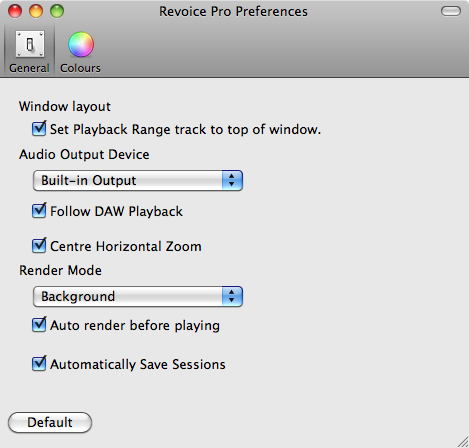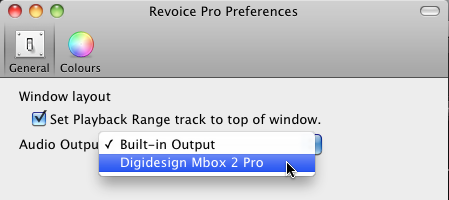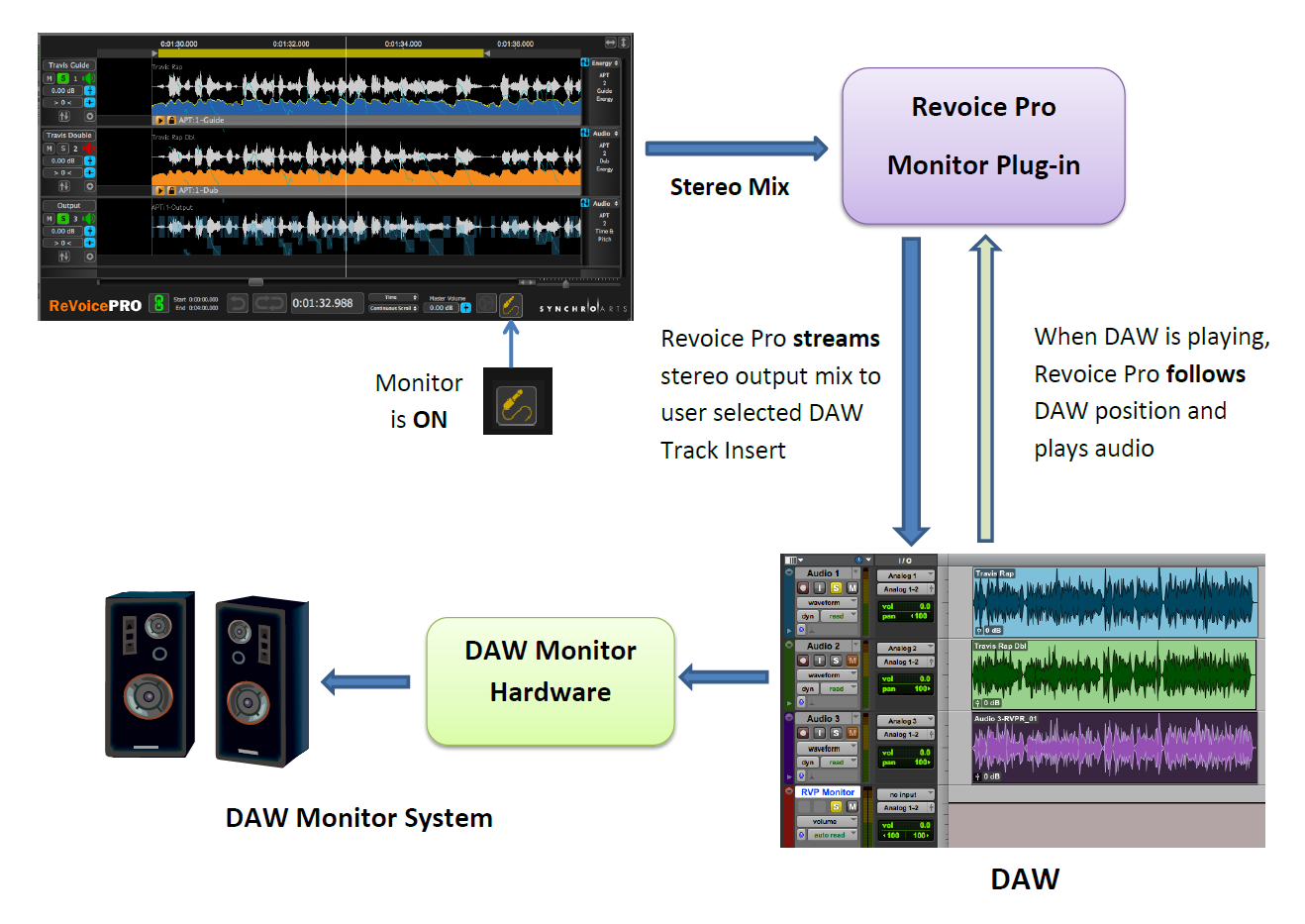Audio Rendering and Monitoring
Rendering and background processing
All Revoice processes have to be rendered to create audio tracks before they can be auditioned or the results saved/exported. From v3.1 onwards this rendering process can now be done in the background while you continue to work, or it can still be done as for earlier versions, either upon pressing the space bar to play the output track, by pressing the Run Process cogwheel button at the bottom of the display, or by pressing CMD-R. The processing cogwheel shows red when a process needs to be rendered or red and turning when the system is processing.
![]()
If a process has not yet been rendered, a red line will show across the top of the track concerned.
To set the Render Mode open Revoice Pro > Preferences, and choose from one of the three options shown below:
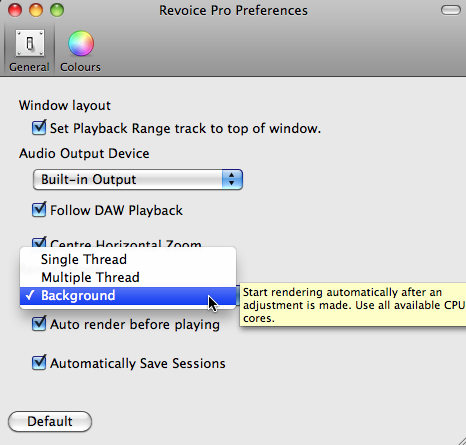
Single Thread does not work in the background and uses just one CPU core.
Multiple Thread does not work in the background and uses all available CPU cores.
Background works in the background and uses all available CPU cores.
Select Auto render before playing when background processing is off to have Revoice Pro render audio automatically when you start to play an unrendered track. If unchecked you have to press the Run Process button shown above, or press CMD-R, to render audio manually.
Audio monitoring
Because Revoice Pro is a stand-alone program, the audio playback needs to be directed to a monitoring system to be heard.
Revoice Pro can route its stereo mix of enabled tracks in two basic ways.
- Directly - to audio hardware supported by your computer's operating system.
- Indirectly - by feeding Revoice Pro's stereo output to a track Insert in your DAW (if it supports RTAS, VST3 or AU insert plug-ins) and routing the output of that track to your DAW monitor system. This method uses the Revoice Pro Monitor plug-in
Audio Monitoring Options |
Advantages / Disadvantages / Comments |
|---|---|
Directly |
|
Indirectly via: |
|
Both of these methods can be set up at the same time, but only one at a time can be used, depending on whether the Monitoring switch, for Revoice Pro Monitor is ON or OFF in Revoice Pro. This is described in detail below.
Setting Audio Output Options
The Audio Output settings are controlled in the Revoice Pro Preferences menu.
- Go to Mac OS Setup
- Go to Windows OS Setup
Mac OS Setup
To set the Directly-connected audio hardware, in the Revoice Pro menu bar, under Revoice Pro, select Preferences and then the General tab.
The menu similar to that in the first image below should appear and the user can select the Audio Output Device drop-down menu to chose Built-in Output or other directly connected audio hardware listed as shown in the second image below (in this example, an Mbox 2 is being selected).
NOTE: This does NOT apply to Pro Tools HD hardware, which is discussed separately below.
To continue the setup, click link below:
Windows OS Setup
To set the Directly-connected audio hardware, in the Revoice Pro menu bar, in the Edit menu, select Preferences.
The menu similar to that shown below should appear and the user can select the Audio Output drop-down menu to chose Speakers as shown, or any other directly connected audio hardware that appears in the list.
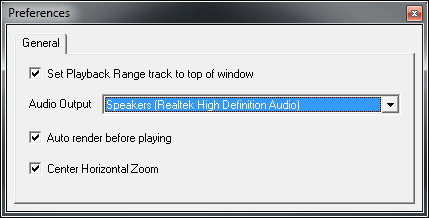
The next section describes how to set up monitoring Revoice Pro through your DAW audio hardware (indirectly connected), if you have installed the Revoice Pro Monitor plug-in.
Back to Index
Revoice Pro Monitor plug-in
This section explains how to listen to Revoice Pro's playback through Pro Tools-, VST3- or Logic (AU)-based DAW hardware.
From version 3.1 of Revoice Pro, the Preferences control panel contains a "Follow DAW Playback" checkbox. If this is checked Revoice playback will start and follow the DAW in sync whenever the DAW is played. If turned off, Revoice replay will not follow the DAW.
The main functions are:
- If the DAW is not playing, Revoice Pro controls the playback in Revoice Pro.
This method also plays back scrubbing and looping within Revoice Pro. - If the DAW starts to play and "Follow DAW Playback" is checked in Preferences, Revoice Pro also plays back, following the DAW's play head location.
(Audio synchronization is sample accurate on the systems we have tested). - NOTE: Starting Revoice Pro playback does not put the DAW into play mode.
Overview and functions of the Revoice Pro Monitor plug-in
Setting up Revoice Pro Monitor plug-in Pro Tools
- Add a stereo Aux track into your DAW session. (The Monitor plug-in only works with stereo tracks)
- Insert the Revoice Pro Monitor plug-in into the track as shown below in the example for Pro Tools.
The plug-in in Pro Tools is under:
multichannel plug-in / Other / Revoice Pro Monitor (stereo)
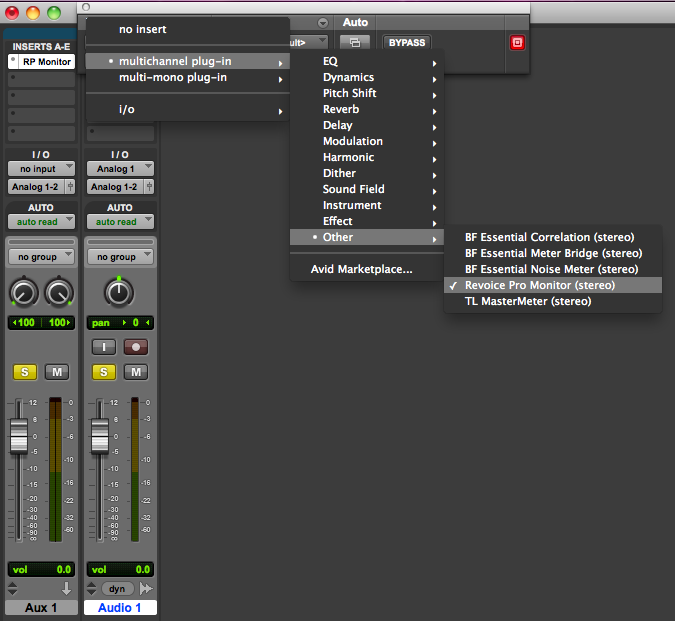
- Note that the Revoice Pro Monitor plug-in (as shown for Pro Tools below) has no controls.

- To enabling the Monitor, switch it on using the Monitor Enable button shown ON below

If you switch this Monitor switch OFF, then the output will be sent to the directly connected device set up as the Audio Output.
PRO TOOLS 11 WARNING: In Pro Tools 11 you must disable (untick) Dynamic Plug-In Processing in the Playback Engine window shown below. Otherwise, Pro Tools will stop getting audio from the plug-in after a period of silence.
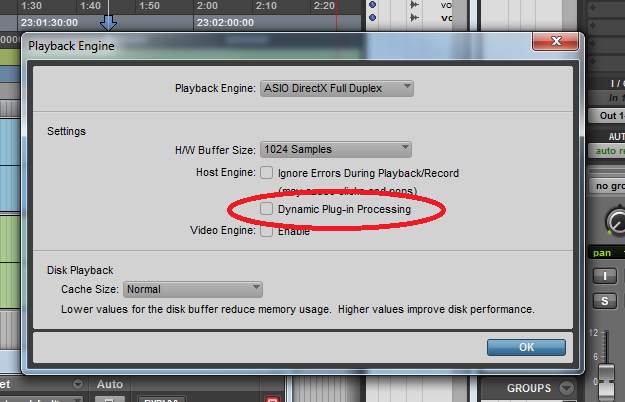
Back to Index
Setting up Revoice Pro Monitor plug-in VST3
These instructions are for Cubase but should also apply to other VST3 hosts.
Instructions for Nuendo differ slightly and are provided here.
1) In Cubase select the Devices -> VST Instruments menu item.
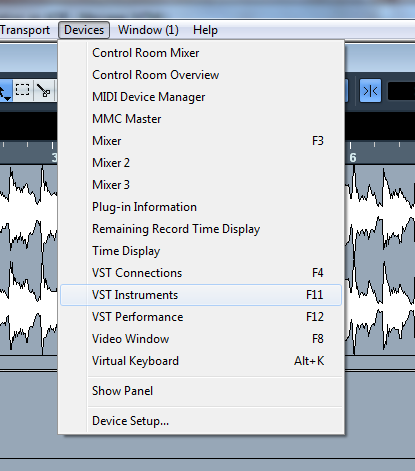
2) The VST Instruments dialog will be displayed.
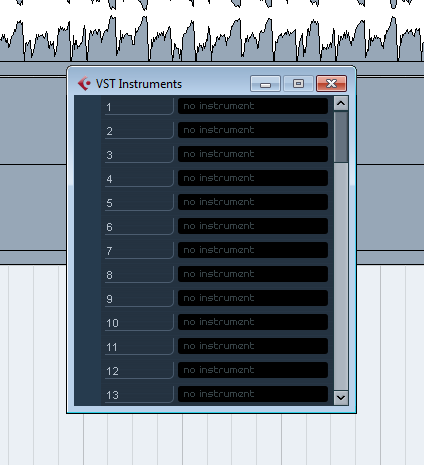
3) Select one of the entries in the dialog and a menu will be displayed showing the available instruments. Select Revoice Pro Monitor.
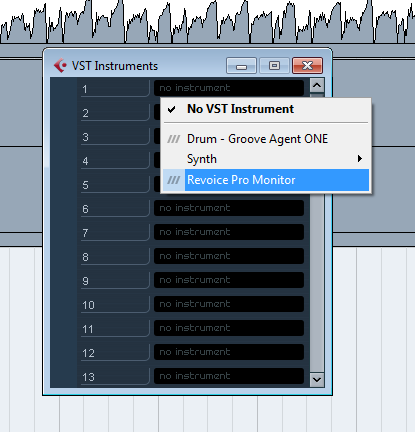
4) You will be asked if you want to create a MIDI track you can select Cancel.
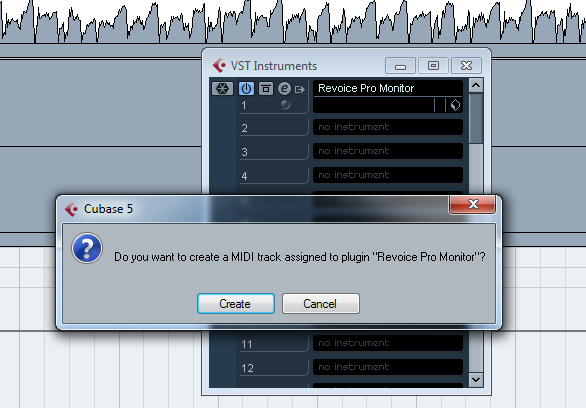
5) The Revoice Pro Monitor will be displayed in a window.
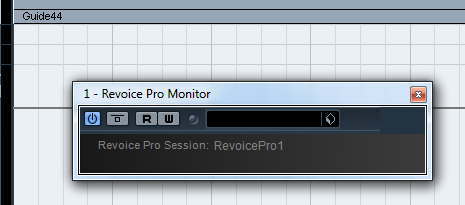
6) In Revoice Pro check that the monitor button is enabled.

7) In Cubase check the Release Driver when Application is in Background option is not checked.
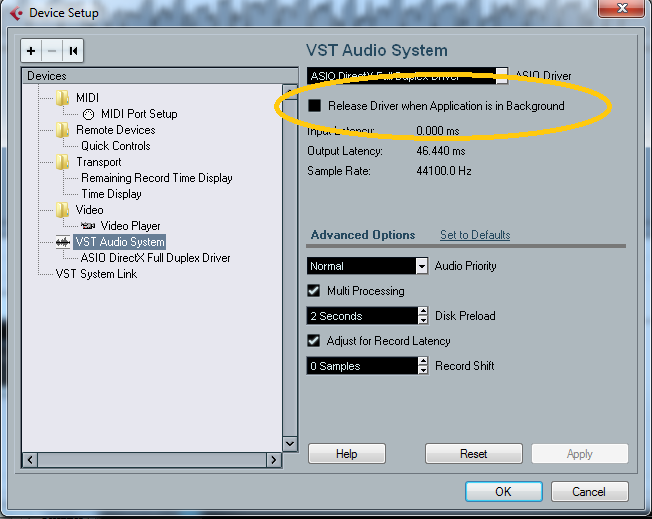
If this option is checked when you try and start playing from Revoice Pro the operaiton will fail because Cubase is in the background.
You should now be able to start playing from Revoice Pro or from Cubase.
Setting up Revoice Pro Monitor plug-in Logic X (Audio Units)
1. In Logic, create a New Software Instrument Track.
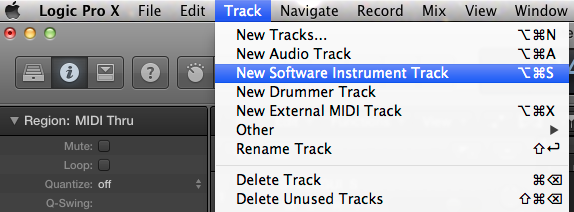
2. The track will be added to the list of existing tracks in the session, here shown as Track 4 (Inst 1):
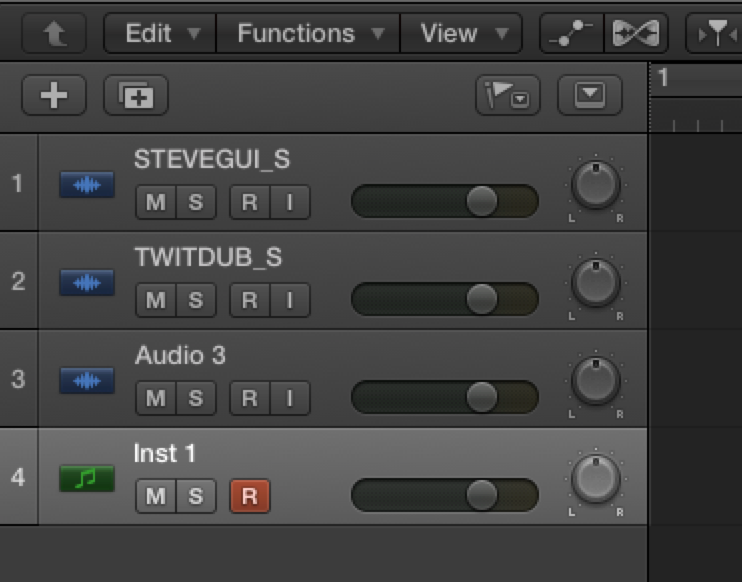
3. Make sure the track is selected, then click on the the Inst button on the mixer strip for that track, to show the menu of available instruments, and selected AU Generators > Synchro Arts > Revoice Pro Monitor > Stereo:
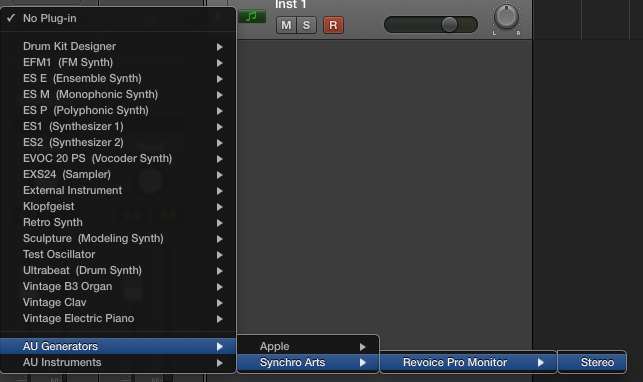
4. The Inst button now shows "Revoice Pro":
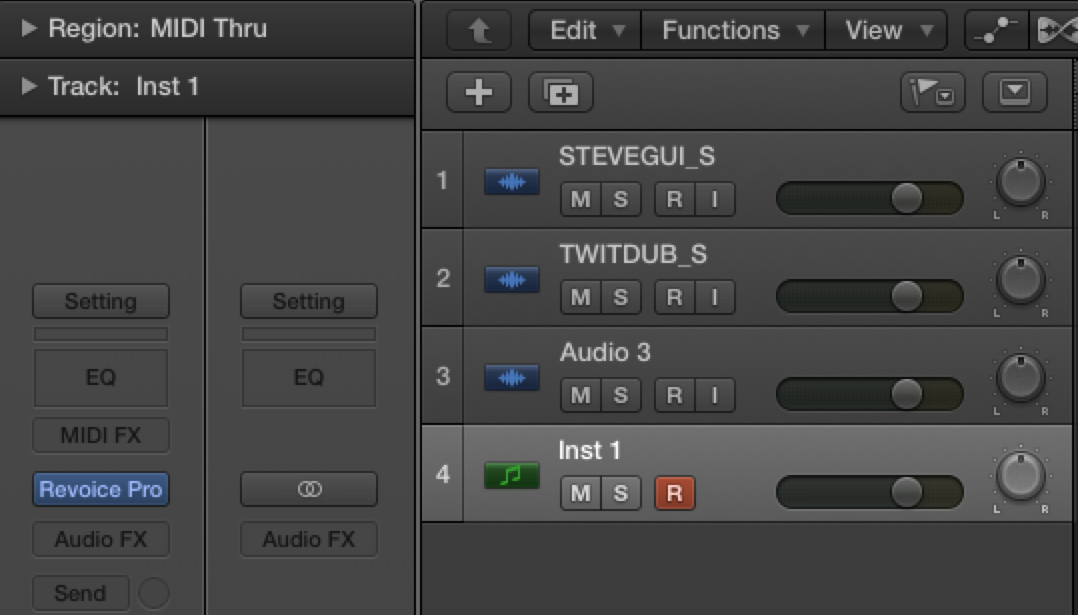
5. To enabling the Monitor via this track in Logic, switch it on using the Monitor Enable button in Revoice shown ON below:

If you switch this Monitor switch OFF, then the output will be sent to the directly connected device set up as the Audio Output.
Back to Index
Monitoring through Pro Tools HD hardware
There is currently a range of Pro Tools HD audio hardware that does not allow 3rd party audio inputs when Pro Tools is running. All versions of Pro Tools HD currently do NOT offer a 'release audio' function. The DAE engine in HD takes over the computer, and while Pro Tools is open, only allows PT to pass audio through the Digidesign hardware.
In this case, using the Revoice Pro Monitor plug-in is a good option, but another options the user can try is a Digital Audio Link between the Mac and the HD hardware.
Digital Audio Link
(This has been reported working with Pro Tools HD 10.1.2 with HDX hardware and multiple HD
interfaces on a MacPro 2008 8-core running Mac OS 10.7.3).
A simple HOSA TOSlink to AES-converter can be connected between the TOSlink digital output of the Mac and one of the
AES inputs on an AVID HD interface. Also, the sample rate converter on that AES input can be used to integrate
the asynchronous digital output signal of the Mac. Or you can
clock the Mac to a TOSlink S/Pdif signal on the digital input (you need
to use an "Aggregate device" using just the stereo digital input and
output of the Mac in the AudioMIDI setup of OS X to achieve this). Most lower-end audio interfaces have a TOSlink S/Pdif input.
Then, in Pro Tools you need an open aux input for the stereo AES input
signal.

